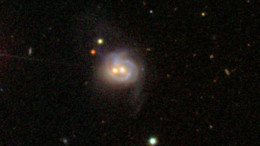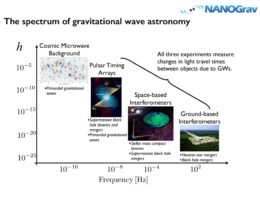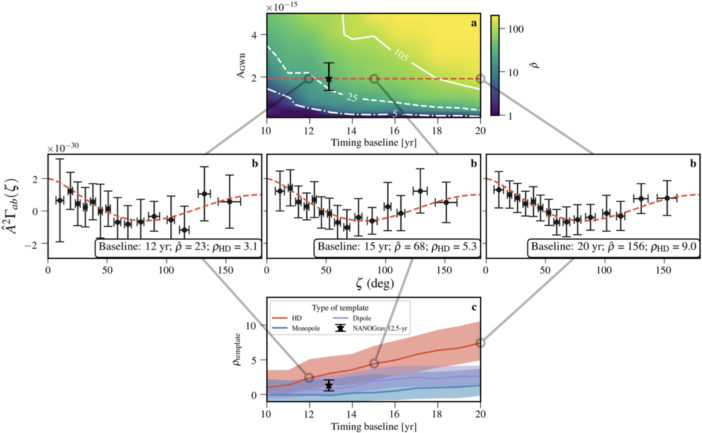For decades, scientists have used networks of pulsars to search for a faint, background gravitational-wave signal that should pervade our universe. What have they found so far, and what can we expect in the future? A new publication details the possibilities.
Humming in the Background

Mrk 739 is an example of a galaxy merger where the two nuclei at the center of the newly-formed galaxy are still in the process of merging. [SDSS]
When galaxies collide, the supermassive black holes at their centers should also form binaries, inspiral, and merge. The combination of all inspiraling supermassive black hole binaries across the universe should produce a deep background hum of gravitational waves — a signal that we could detect, with the right tool. Enter: pulsar timing arrays (PTAs).
Cosmic Clocks
PTAs rely on the remarkably consistent timing of flashes of light from a network of spinning neutron stars — pulsars — to measure the stretching of the spacetime in which these pulsars are embedded.

An artist’s illustration showing how a network of pulsars could be used to search for the ripples in space-time. [David Champion/NASA/JPL]
A Hint of a Signal
How are PTAs doing so far? The North American Nanohertz Observatory for Gravitational Waves (NANOGrav) has been searching for the gravitational-wave background for more than a decade — until now, without success. But the longer we observe the timings of a set of pulsars, the more subtle a signal we can detect.
The 12.5-year dataset released this year offers a first glimpse of hope: this most sensitive dataset yet shows signs of a signal consistent with the predicted gravitational-wave background. Definitive evidence of the background will require longer observations with NANOGrav to beat down the noise and reveal an expected set of correlations between pairs of pulsars.

The gravitational wave spectrum and detectors. Here, frequency of the gravitational waves is plotted against strain (the fractional change in the separation between objects caused by the passage of the gravitational wave). Click to enlarge. [NANOGrav]
Milestones Ahead
Pol and collaborators identify three key milestones that we should soon achieve.
- Robust evidence of the gravitational-wave background should be possible with 15–17 years of data — only another 2–5 years beyond the 12.5-year dataset already published.
- The signal detected at this time will already contain enough information to identify whether the gravitational-wave background is caused by supermassive black hole binaries, as anticipated, or if it instead has more exotic origins, like primordial black holes or cosmic strings.
- If the signal is caused by supermassive black holes, the initial detection will also be sufficient to distinguish between different population models for supermassive black hole binaries.
This work illustrates that NANOGrav has the potential to provide us with a wealth of information in the next few years! What’s more, those results will come even faster with the addition of new pulsars to NANOGrav’s network, or the combination of data from multiple PTAs. Gravitational-wave astronomy is truly only just getting started!

Top: Evolution of the signal-to-noise ratio as a function of time observing the pulsars. Middle: The predicted correlation signal between pulsars after 12 years, 15 years, and 20 years, compared to the model (dashed red line) showing the presence of a gravitational-wave background. Bottom: The signal-to-noise ratio of the correlation signal as a function of observing time. [Pol et al. 2021]
Citation
“Astrophysics Milestones for Pulsar Timing Array Gravitational-wave Detection,” Nihan S. Pol et al 2021 ApJL 911 L34. doi:10.3847/2041-8213/abf2c9
